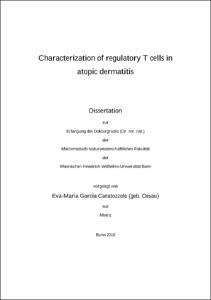Characterization of regulatory T cells in atopic dermatitis

Characterization of regulatory T cells in atopic dermatitis

| dc.contributor.advisor | Novak, Natalija | |
| dc.contributor.author | Garcia Caratozzolo, Eva-Maria | |
| dc.date.accessioned | 2020-04-26T09:24:28Z | |
| dc.date.available | 2020-04-26T09:24:28Z | |
| dc.date.issued | 05.02.2019 | |
| dc.identifier.uri | https://hdl.handle.net/20.500.11811/7848 | |
| dc.description.abstract | Atopic dermatitis (AD) is one of the most common chronic inflammatory skin diseases with increasing incidence. It has been suggested that Tregs play a role in the pathogenesis of AD, as Tregs regulate immune homeostasis by modulating the immune system response. Even though the role of Tregs in this disease has been studied for several years, their part in it is still not clear. The objective of this study was to characterize the phenotype, the induction and function of Tregs in patients with AD compare with healthy controls. Therefore, circulating Tregs and T cell subsets of AD patients and healthy individuals were quantified by flow cytometry. Interestingly, only CD4+ CD25+ Foxp3+ Tregs were found to be expanded in the blood of AD patients. Quantification of the TSDR, a specific region in the Foxp3 locus, affirmed that the frequency of nTregs was increased in AD. This was in line with several preceding studies. In contrast, the TGF-β-dependent conversion of CD4+ CD25- Foxp3- into CD4+ CD25+ Foxp3+ iTregs was impaired in AD patients, which supported the evidence that TGF-β signaling might be malfunctioning in AD. Indeed, reduced expression of Smad 3 mRNA was revealed in CD4+ CD25- T cells, which was accompanied by a tendency of less p Smad 2/3. This might have a direct effect on TGF-β signaling driven gene expression, such as Foxp3. Interestingly, Smad 3 has already been associated with AD as Smad 3/4 mRNA was down-regulated in human skin lesions of AD patients. Additionally, Smad 3 deficiency in an AD mouse model led to allergen-induced skin inflammation. Alterations observed in TGF β R and Smad 7 expression might display a secondary effect as a result of impaired signaling. Besides the expressional characterization of Tregs, their suppressive function was tested in an in vitro co-cultured with assay autologous T responder cells. iTregs derived from AD patients inhibited proliferation similar to those from healthy donors. Hence, their suppressive function was not impaired in vitro. Furthermore, the role of the transmembrane protein GARP was investigated in Tregs in the context of AD. It was shown that the missense mutation A407T in the LRRC32 gene led to a reduced surface expression of GARP together with a malfunction of AD-T cells conversion into iTregs. In conclusion, this study supplied strong indication for an important involvement of Tregs in AD pathology. Evidence was provided for malfunction in TGF-β signaling leading to impaired iTreg generation which could explain why inflammatory immune response is not down regulated properly in the skin of AD patients. | |
| dc.language.iso | eng | |
| dc.rights | In Copyright | |
| dc.rights.uri | http://rightsstatements.org/vocab/InC/1.0/ | |
| dc.subject | Atopische Dermatitis | |
| dc.subject | regulatorische T-Zellen | |
| dc.subject | TGF-b signaling | |
| dc.subject | atopic dermatitis | |
| dc.subject | regulatory T cells | |
| dc.subject.ddc | 570 Biowissenschaften, Biologie | |
| dc.title | Characterization of regulatory T cells in atopic dermatitis | |
| dc.type | Dissertation oder Habilitation | |
| dc.publisher.name | Universitäts- und Landesbibliothek Bonn | |
| dc.publisher.location | Bonn | |
| dc.rights.accessRights | openAccess | |
| dc.identifier.urn | https://nbn-resolving.org/urn:nbn:de:hbz:5n-53256 | |
| ulbbn.pubtype | Erstveröffentlichung | |
| ulbbn.birthname | Oesau | |
| ulbbnediss.affiliation.name | Rheinische Friedrich-Wilhelms-Universität Bonn | |
| ulbbnediss.affiliation.location | Bonn | |
| ulbbnediss.thesis.level | Dissertation | |
| ulbbnediss.dissID | 5325 | |
| ulbbnediss.date.accepted | 22.11.2018 | |
| ulbbnediss.institute | Mathematisch-Naturwissenschaftliche Fakultät : Fachgruppe Molekulare Biomedizin / Life & Medical Sciences-Institut (LIMES) | |
| ulbbnediss.fakultaet | Mathematisch-Naturwissenschaftliche Fakultät | |
| dc.contributor.coReferee | Förster, Irmgard |
Files in this item
This item appears in the following Collection(s)
-
E-Dissertationen (4077)




